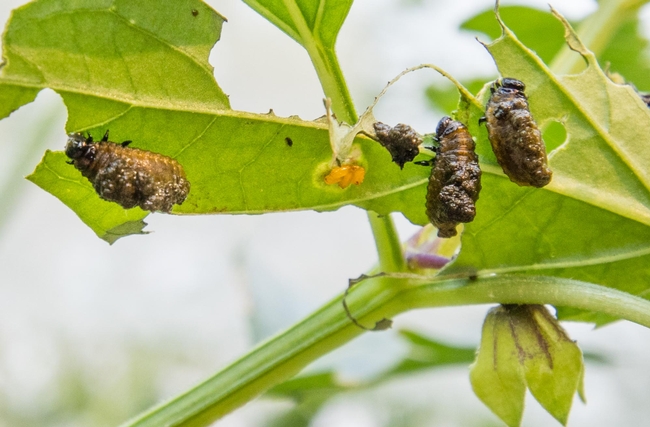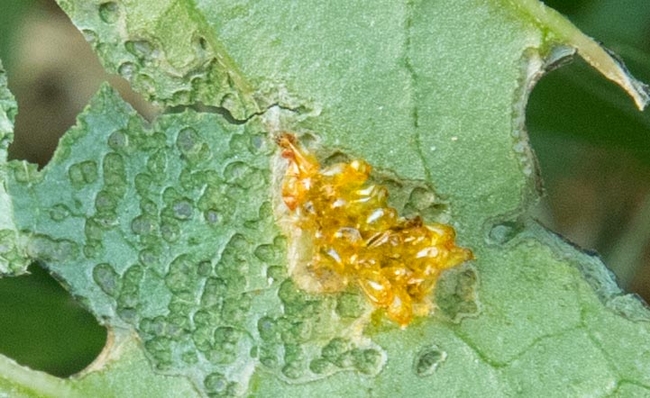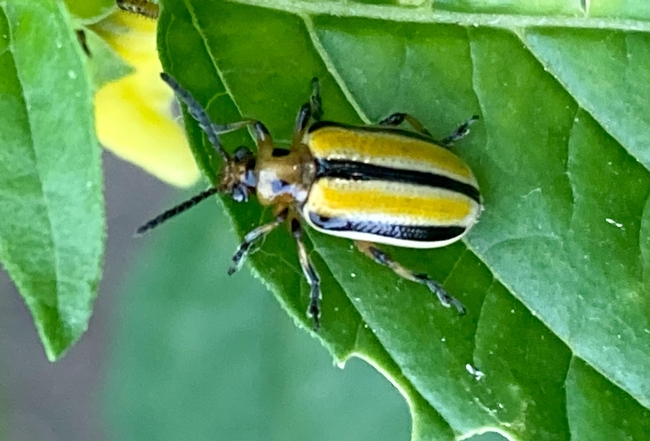Tomatillos (Physalis ixocarpa) are so easy to grow, they are almost weeds. Since I first grew them long ago, they have returned to my garden every year, reseeding with gusto and growing like… weeds. They have been productive and trouble free for me, until last year.
Late last summer, when fruit was forming but hadn't ripened, I noticed holes in the leaves, lots of them. On inspection, I found numerous small larvae all over the plants. They looked like tiny slugs with little piles of brownish stuff on their backs that looked kind of like poop. As I searched among the plants, I brushed against their leaves, and on leaving the garden I noticed that my hands and clothing were covered with a brown substance that looked and felt just like poop.

I couldn't find anything about this beetle on the UC IPM website or in any UC ANR publications, but there was information on agricultural extension websites from Maine, New Hampshire and Minnesota. Closer to home, I found a good info sheet from Utah State University. This pest may be a relative newcomer to our state. In any case, it has made itself at home in my garden.

I learned that these beetles may overwinter either as larvae or as adults. Although they did not appear until late last season, they seem to have spent last winter in or near my garden and thus were able to get a much earlier start this year.
Some of the sources I consulted dismissed the potential for crop damage as minor, but that has not been my experience. Last year's plants were largely defoliated and I didn't get much of a crop. If you notice that something is chewing on your tomatillos' leaves, it is time to take immediate action.
If you see the larvae, adults, or eggs, you can try hand picking them; sources recommend dropping them into a container of soapy water. If you try this with the larvae, you may want another container of soapy water for your hands. This is truly the most disgusting pest I have ever encountered. They are less smelly than squash bugs, but the ick factor is real. Since the infestation in my garden was too extensive for me to hand pick individuals, I tried washing them into a bucket with the hose, which didn't work as well but did keep everything cleaner.
If you suspect that these beetles have arrived in your neighborhood, a proactive approach will be more effective. Solanaceous weeds, especially Physalis species (ground-cherries), act as alternate hosts and should be removed (by the same token, cultivated ground-cherries should be protected). Although I didn't see it mentioned, Datura, either wild or cultivated, would presumably be another target. Floating row covers placed early in the season can exclude the overwintering generation from your tomatillos.
Pesticides are not recommended except where there's the potential for real economic damage, an unlikely scenario in a home garden. Despite their name, three-lined potato beetles are reportedly not very interested in potatoes, or tomatoes, peppers, eggplants or almost any other solanaceous vegetables except tomatillos.
I have been gardening in the Eastern Sierra for more than forty years, and this beetle is new to me. Based on the paucity of information I've been able to find, I'm guessing it may be new to this part of the country. I hope my story will help other gardeners prepare for their arrival in their own gardens, and to recognize and manage them when they get there.
Here's a link to the fact sheet from Utah State University, with more information and pictures:
https://extension.usu.edu/pests/research/three-lined-potato-beetle
